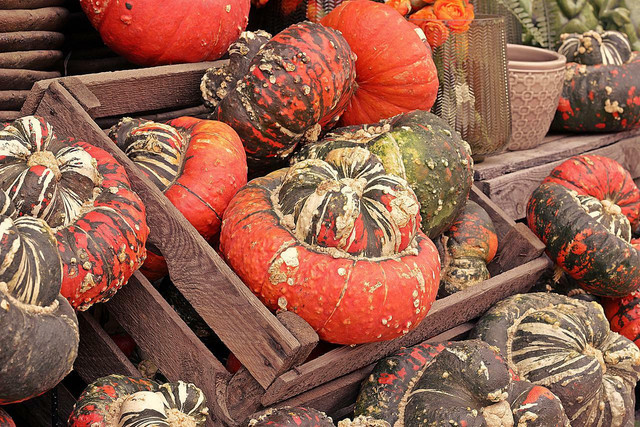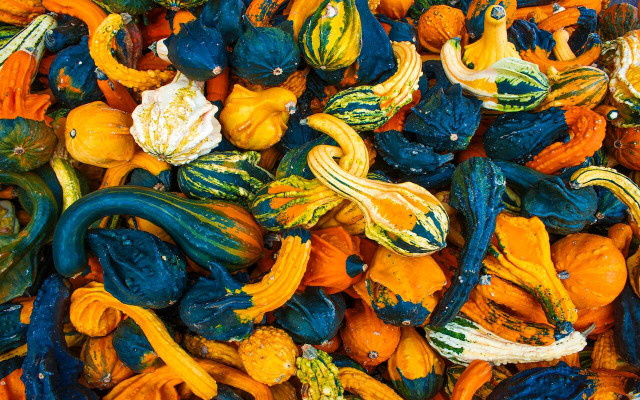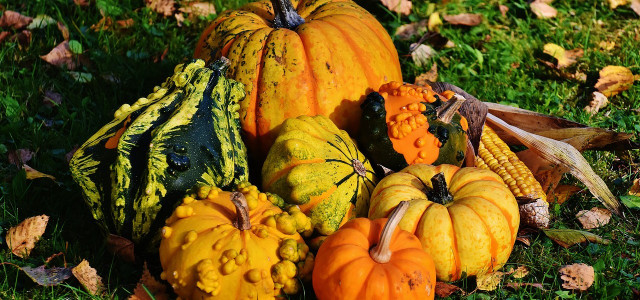Gourds come in all shapes and sizes and have been grown, eaten, and dried for various uses over hundreds of years – learn how to dry gourds here!
In general, the term gourd is applied to the dried hard-shell fruits of the flowering plant family Cucurbitaceae. Grown in temperate climates, gourds are some of the earliest known fruits and cultivated plants. As well as being decorative, gourds have been used as water carriers, musical instruments, and storage containers in cultures from Ancient Egypt and early North American indigenous communities. Today, gourds still serve a multitude of purposes.
Some gourds are edible however most that you find in the shop are classed as ornamental since they have very tough skin, or they simply just don’t taste very nice. You can also grow pumpkins and gourds yourself if you have enough sunlight and rich, well-drained soil. There are hundreds of species that come in all sorts of strange shapes and sizes, gourds from the genus Cucurbita are mostly native to North America, these include:
- Turban Squash, Cucurbita Maxima
- Butternut squash, Cucurbita Moschata
- Zucchini, Cucurbita Pepo
- Acorn squash, Cucurbita Pepo var. Turbinata
- Pumpkins, although what is called a pumkin varies, they are mostly part of the Cucurbita genus.
Since all these gourds are part of the same family, and they can all be dried and stored in the same ways.
Harvesting Gourds for Drying

(Foto: CC0 / Pixabay / pixel2013)
These fruits should be harvested when the stems turn brown on the vine, before they over ripen and before the first fall frost as the cold can ruin the skin. You must also make sure the gourd is fully colored and has a hard outer skin.
Harvesting your gourds prematurely could also lead them to rot, so make sure the stem has died before picking them. Use a sharp serrated knife or shears to cut through the stem near the green part of the vine leaving a few inches of the stem attached to the gourd. Not only does keeping the stem helpful during the drying process, but it also encourages water to evaporate from the gourd.
Don’t pull the gourd to remove it as this could damage the fruit. Damaged areas on the gourd are invitations for rot, so you should either eat or discard any gourds that are bruised or spoiled. They will decay while they are in storage, and the rot might spread to neighboring gourds. Check out our recipe for a vegan winter squash soup made with any squash for a tasty way to not waste any of your gourds!
How to Dry Gourds



(Foto: CC0 Public Domain / Unsplash / Jan Huber )
Once you’ve harvested your gourds, it’s time to dry them. Learn how to dry gourds using the following instructions:
- Suspend your gourd. If your gourd has a stem, tie a string around it and suspend it from a beam. If your gourd does not have a stem or if it’s too heavy, you can also place it in a paper bag with handles to hang it up.
- Store in a cool and dry location, away from damp. Ideally, you need to keep them at around 55 to 65 degrees, but not too warm because they will attract mold.
- Wait for six months to a year for your gourd to be fully dry.
Now you can use your gourd however you please!
As soon as they’re dried they pretty much tend to stay the way that they are when they were harvested. You can keep them for months and months and even years.
If you want to keep a larger gourd for decoration and want to speed up the drying process, you can always cut a little hole in the bottom and then clean out the insides before hanging it up to dry.
Read more:
- How to Dry Chives: Tips for Harvesting, Drying & Storing
- You Can Eat These Types of Squash Raw
- How to Dry and Preserve Flowers: 3 Easy Methods
Important Information regarding Health-related Topics.
** Links to retailers marked with ** or underlined orange are partially partner links: If you buy here, you actively support Utopia.org, because we will receive a small part of the sales proceeds. More info.Do you like this post?






